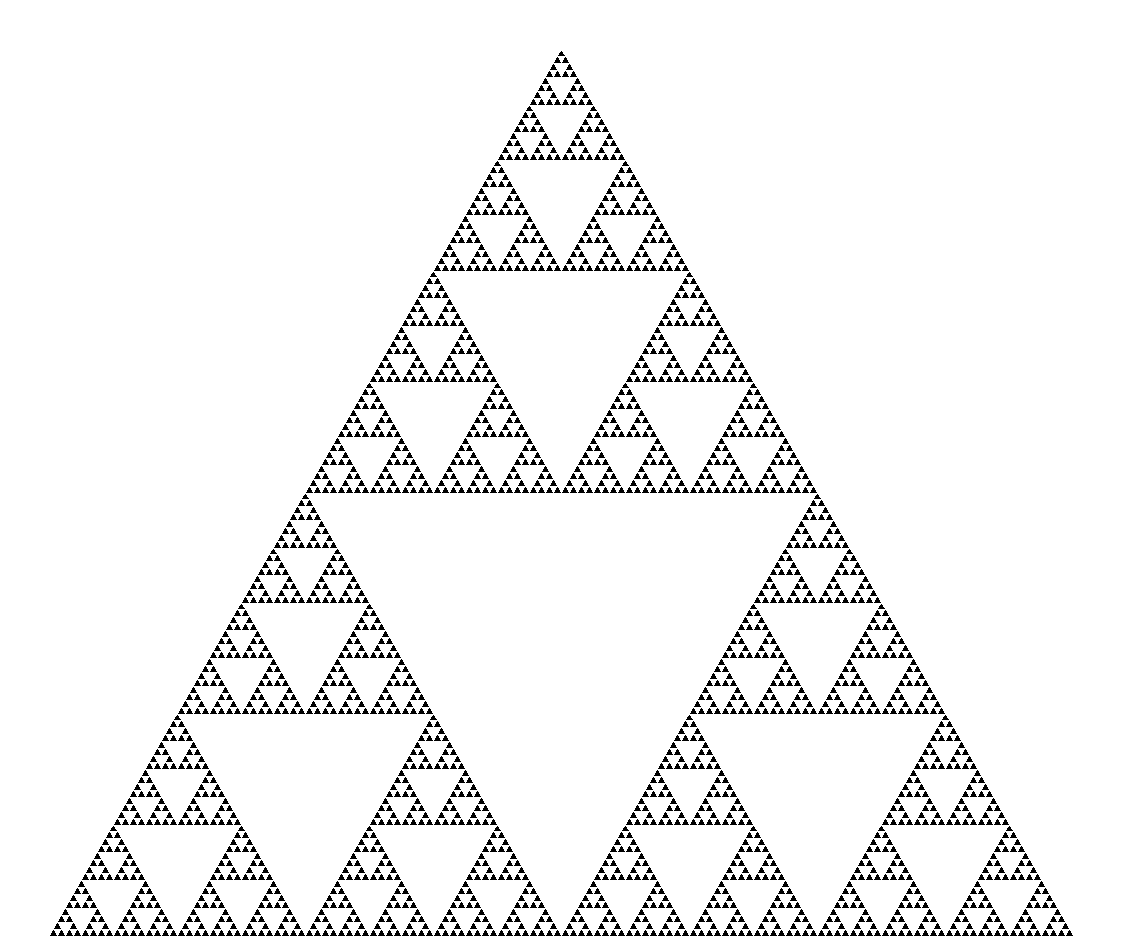Recently I’ve watched a video showing how to draw an approximation of the Sierpiński triangle on paper using the following steps1:
- Plot three points to form an equilateral triangle
- Randomly select any point inside the triangle and consider that your current position
- Randomly select any of the triangle’s vertices
- Move half the distance from your current position to the selected vertex
- Plot the current position
- Go to step 3
I found it absolutely fascinating, and at the same time I was extremely skeptical. My mind couldn’t comprehend how following those simple steps could possibly yield this magnificent shape:

|
|---|
| The Sierpiński triangle 2 |
Therefore, naturally, I had the overwhelming urge to write some code to verify the outcome of the video that I’d just watched.
So here goes:
<!-- index.html -->
<!DOCTYPE html>
<html>
<head>
<title>The Sierpiński triangle</title>
<meta charset="UTF-8" />
</head>
<body style="background-color: black;">
<canvas id="canvas" width="800" height="800"></canvas>
<script src="index.js"></script>
</body>
</html>
// index.js
(async function () {
// Capture canvas element.
const canvas = document.querySelector("#canvas");
if (!canvas.getContext) {
return;
}
// Capture canvas's 2D rendering context.
const canvasContext = canvas.getContext("2d");
const { width: canvasWidth, height: canvasHeight } = canvas;
// Configure canvas's context.
canvasContext.font = "30px monospace";
canvasContext.fillStyle = "white";
// Define the coordinates of the triangle's vertices.
const lowerLeftVertex = { x: 0, y: canvasHeight };
const lowerRightVertex = { x: canvasWidth, y: canvasHeight };
const topVertex = { x: canvasWidth / 2, y: 0 };
const vertices = [lowerLeftVertex, lowerRightVertex, topVertex];
const midpoints = [];
// Plot the triangle's vertices.
vertices.forEach(drawPoint(canvasContext));
// Repeat 20 thousand times.
for (let i = 0; i < 20_000; i++) {
// Select a vertex at random.
const randomVertex = getRandomElement(vertices);
// Get the last midpoint.
const lastMidpoint =
midpoints[midpoints.length - 1] ?? getRandomElement(vertices);
// Compute the midpoint between the randomly selected vertex and the last
// midpoint from the previous iteration (i.e. current position).
const newMidpoint = computeMidpoint(randomVertex, lastMidpoint);
midpoints.push(newMidpoint);
// Draw the newly computed midpoint.
drawPoint(canvasContext)(newMidpoint);
// Re-render iteration count.
updateIterationCount(canvasContext)(i);
// Sleep for 1 millisecond to plot the points incrementally and not all at
// once.
await sleep(1);
}
})();
function drawPoint(canvasContext) {
return function (coordinates, size = 1) {
const { x, y } = coordinates;
canvasContext.beginPath();
canvasContext.arc(x, y, size, 0, Math.PI * 2, true);
canvasContext.fill();
};
}
function updateIterationCount(canvasContext) {
return function (i) {
canvasContext.clearRect(0, 0, 200, 50);
canvasContext.fillText(i, 0, 30);
};
}
function getRandomElement(list) {
const randomIndex = Math.floor(Math.random() * list.length);
return list[randomIndex];
}
function computeMidpoint(firstPoint, secondPoint) {
return {
x: Math.floor(Math.abs((firstPoint.x + secondPoint.x) / 2)),
y: Math.floor(Math.abs((firstPoint.y + secondPoint.y) / 2)),
};
}
function sleep(millis) {
return new Promise(function (resolve) {
setTimeout(resolve, millis);
});
}
And sure enough, it produces the promised result:
